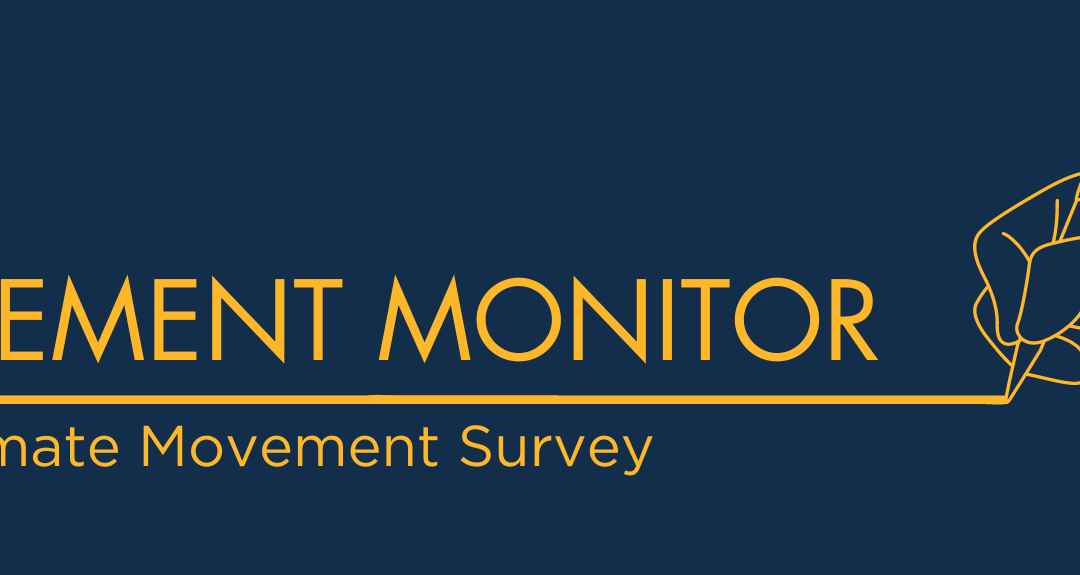Introduction
The Commons Social Change Library conducted a survey of Australian climate organisations in April 2024 as part of the Movement Monitor project. This survey asked groups about what work they do, their organisation and how they work with others. Survey questions focused specifically on the 2023 calendar year. The survey included a combination of both quantitative, multiple choice questions, and open-text qualitative questions. 81 groups provided valid responses to the survey, of these 60 groups responded to most or all of the questions. The average age of the organisations surveyed was 14 years old. The oldest organisation surveyed formed in the 1950s, and the youngest formed in 2023. Just over half of groups surveyed were fully volunteer, the rest ranged in size from having 0.5 to 92 staff members. This survey and the wider Movement Monitor project have been conducted with the support of the Sunrise Project and Boundless Earth.
What are groups working on?
As in the 2022 survey, more than half the groups reported working on cross-sectoral climate policy, targets and/or plans in the 2024 survey. However, it appears that a focus on climate resilience and/or adaptation has increased, as has a focus on transport.
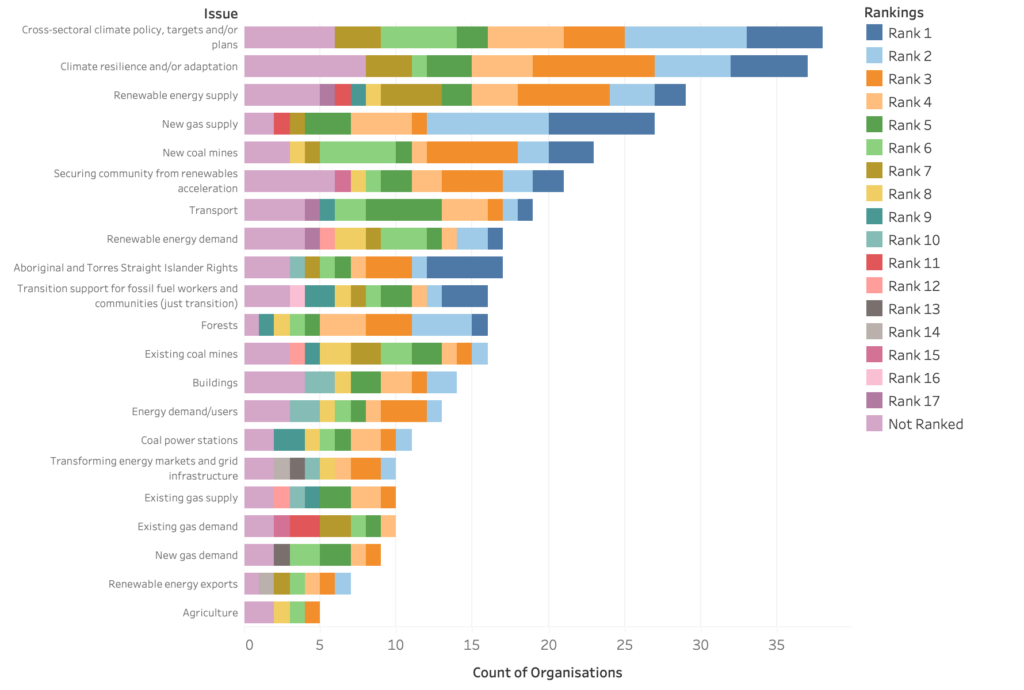
The survey asked groups to identify their top five goals for 2023. Almost half of organisations surveyed (48%) had goals relating to movement building, and the same proportion of groups (48%) were focused on communications or awareness raising. In terms of issue-specific goals, 44% of groups had goals relating to opposing fossil fuels, whereas 25% of groups had renewable energy or electrification targets, and 18% of groups were targeting transport goals. 42% of groups were focussed on influencing climate legislation and government policy, at local council, state and federal levels. Some of these policy goals were more general, looking at “strengthening climate policy”, however others identified specific policy areas, such as the Environment Protection and Biodiversity Conservation Act, the Climate “Duty of Care” bill, and state-based emissions reduction targets. Just 17% of groups surveyed had goals that related to climate justice, for example supporting First Nations justice, economic justice, gender rights and amplifying frontline voices.
When asked to name their top successes for 2023, the responses focussed on policy or legislation change (39%), and stopping fossil fuel projects (22%). Some groups also pointed to more general successes around movement building, or particular tactics or activities (22%). Some of the core wins for 2023 identified by groups in the survey were:
- Getting CommBank out of oil and gas lending
- Getting NAB to withdraw funds from Whitehaven
- The ban on oil and gas in the Channel Country
- Delaying of Woodside’s NWS extension development for another year
- Expansion of the EPBC water trigger
- Senate Inquiry into Middle Arm Industrial Precinct
- Federal Parliament’s Midwinter Ball stops accepting corporate sponsorship
- Federal government commits $10 billion to renewable energy storage
- Australia co-sponsors Vanuatu’s resolution for the International Court of Justice to develop legally enforceable Advisory Opinion on climate change and human rights
- Woolworths makes a commitment to transport fleet and electrification by 2030
- A local council adopts a sports surfaces policy, curbing synthetic turf use
How are groups working?
The survey asked groups what their primary contribution to the climate movement was in 2023. This survey had the same top three responses as the 2022 survey: representing and organising a key constituency, mobilising a supporter base to pressure targets, and lobbying.
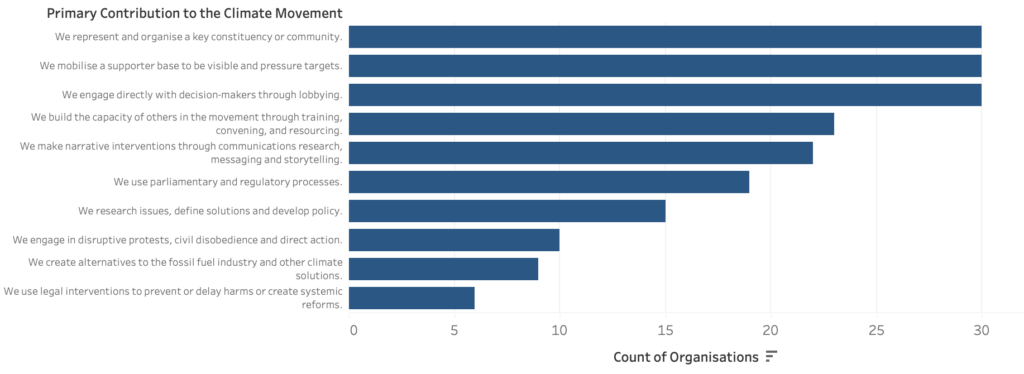
Digital advocacy and coalition building remain the top two tactics used by groups surveyed, with these methods used by the majority of groups in both the 2022 survey and this survey. Where in 2022 non-violent direct action/civil disobedience was the least used tactic (6% of organisations surveyed), there was a slight increase in reports of this tactic in this survey, at 17%. Instead, this year diplomacy and shareholder organising were the least common.
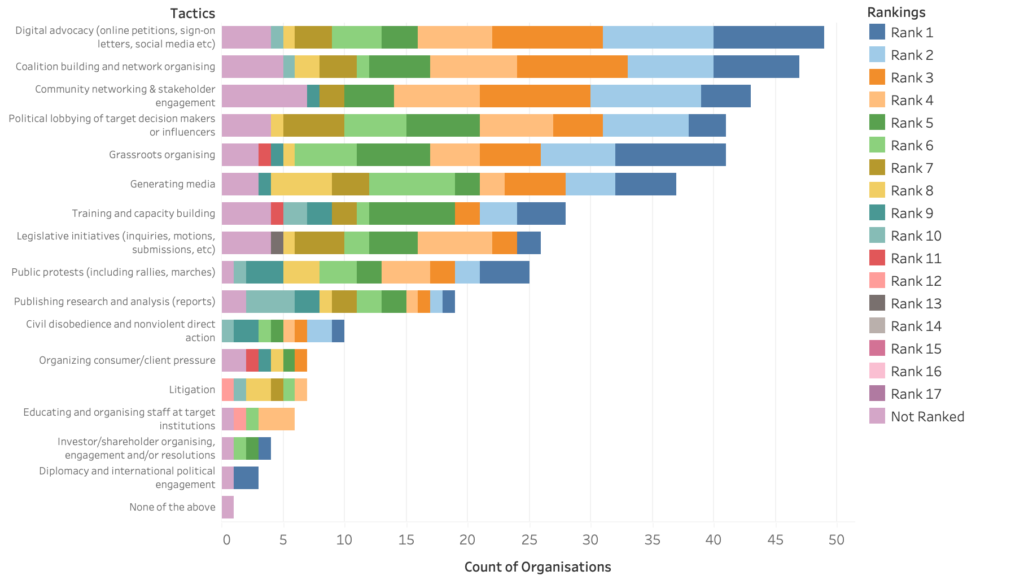
Collaboration appeared as both a strength and a weakness within the movement in survey responses. For some groups (36%), the existence of silos, duplication of work and competition between groups reduced the overall power and capacity of the climate movement. Groups particularly referenced the need to compete for limited funding sources as a barrier to effective collaboration. A third of groups felt that sharing strategy development, reducing competition and building more powerful alliances was a priority to build a stronger climate movement.
There were some groups (30%), however, who already saw collaboration as a strength of the movement. These groups talked about the movement being well-connected, and having high levels of communication and information sharing. While this demonstrates that different groups may be having different experiences of networking and collaboration within the movement, several of the same groups identified collaboration as both a strength and a weakness. This suggests that, for these groups, this issue is a major priority.
Diversity and Justice
“The movement is predominately white and middle class, and lacks diversity in many areas despite the intersectionality of the crisis. The availability of climate change information in different languages is also limited or non-existent.” – Survey response
“the movement is growing to represent more diversity.” – Survey response
As in the 2022 survey, diversity was identified as both a strength and a weakness of the movement by survey participants in 2024. 35% of respondents found that the size, breadth and diversity of the climate movement was a strength. Meanwhile, 37% of respondents found that a lack of diversity, particularly cultural diversity, was a major weakness in the Australian climate movement.
16% groups who responded to the staffing questions recorded that they had First Nations people on staff, 8% of groups reported employing Pacific Islander staff members, 44% reported employing people of colour, 36% reported employing culturally and linguistically diverse (CALD) people, and 22% reported employing people with a disability. Meanwhile, of the organisations who reported having staff members employed, 27% either responded that they were not sure how some or all of their staff members identify, or did not provide a response to the questions on staff identities at all. This suggests that there is still work to do in improving data on diversity within organisations in the climate advocacy sector.
People and Resourcing
“Filled with people who are passionate about making a difference.” – Survey response
“The groups I see rely heavily on the work of a few individuals.” – Survey response
Activists are often driven by a sense of purpose and commitment to the cause. 27% of organisations said the passion and commitment of its people was a major strength of the Australian climate movement. These organisations particularly referenced the determination, resilience, intelligence and passion of climate activists and workers.
Given many organisations see the passion and commitment of people in the climate movement as a major strength, it is important that the movement takes care of and adequately supports these people to participate. However, staff and volunteer burnout and capacity continue to be major challenges. 58% of groups identified staff and volunteer overload/burnout when asked about their challenges. Similarly, 55% said that a major challenge for them was Financial stability/sustainability/fundraising. A major theme that came across was that there was too much work to do without enough resources, and that this work was not being distributed equally among people and organisations in the movement.
For a third of the groups surveyed, funding and resourcing would make the biggest impact in building a more powerful climate movement. Often in these responses, greater funding was tied to greater movement power and diversity, and decreased competition. Groups wanted to see more core, multi-year funding, and higher levels of staffing, particularly in organising roles. Groups also highlighted the need for a more equitable distribution of funds within the movement, with resources reaching smaller, grassroots groups.
“the “urgency” frame is important in the context of climate change, but leads to rapid burnout… grassroots community organisers do the most important work for the movement but are often unpaid, or paid far less than campaigners / organisers working on a national / “high-level advocacy” stage.. this again leads to burnout or an inability to afford to continue the important on-ground work.” – Survey response
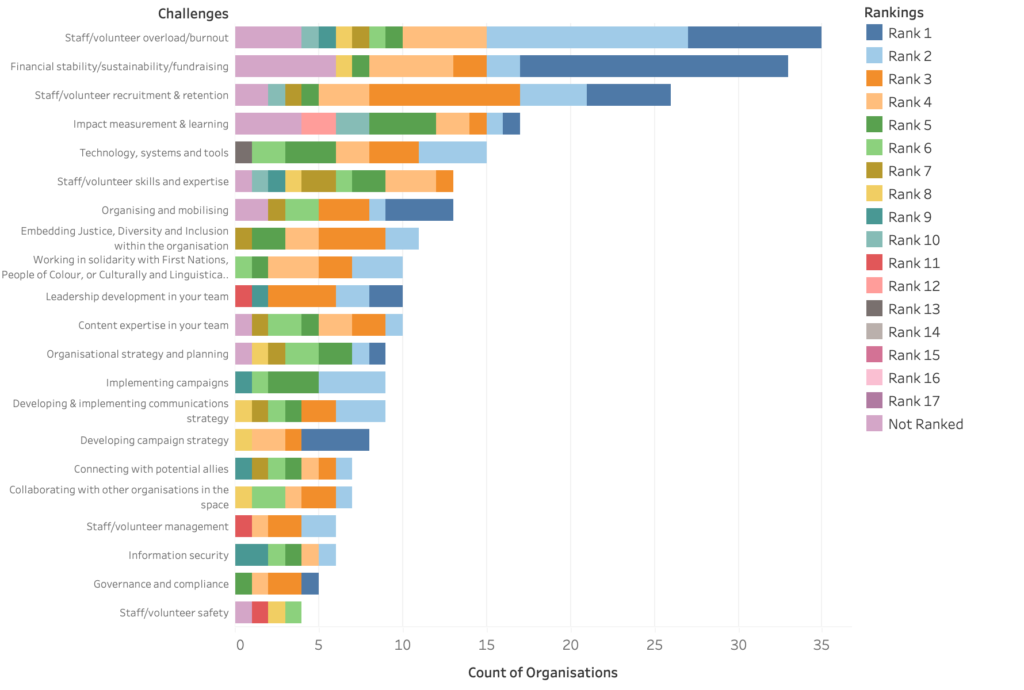
Power, Strategy and Skills in the movement
“The resourcing of organising and people power has diminished over the last 5 years and we are weaker in our ability to mobilise and influence government decisions. There is too much focus on inside track under a Labor government.” – Survey response
“We are currently in a strong position with a Federal government that has ambition to act on climate goals (however this is subject to change)” – Survey response
Groups saw a lack of power as a core weakness of the movement. While this was partly due to a lack of resourcing (financial and staffing), groups also saw opportunities to improve the overall strategic capacity of the movement. Over half of groups had goals relating to movement building in 2023. Groups generally wanted to see a bigger, more powerful, more strategic climate movement. For some groups this meant improving the strategic capacity of the movement, through better strategy development and more effective tactics. Others were focused on increasing movement-building, either by focussing on particular constituencies (such as young people, First Nations people or people of colour), or increasing the general appeal of the movement to “everyday” members of the public. In the responses, improved power and strategy often seemed to go hand-in-hand with greater diversity and improving on-the-ground connections with local communities. As in the 2022 survey, there also appeared to be varying understandings of strategies, tactics and outcomes within the movement. Increasing core literacy in social movement strategy development may be important for improving the strategic capacity of the movement.
“We are a great grassroots organisation which is really supportive and helps to share resources and information between smaller groups” – Survey response
“Our ability to foster collaborations across various sectors, including engagement with all levels of government, and maintain engagement through regular workshops, summits, and strategic meetings has enabled us to amplify our collective impact significantly.” – Survey response
The Australian climate movement appears to be highly skilled across several core areas. While the Movement Monitor project aims to complete a more comprehensive skills audit in the second half of 2024, the 2024 survey did gather some information on skills in the movement. From survey responses, the climate movement appears to have particularly wide-spread skills in: media and messaging, grassroots organising, and coalition building. The prioritising of these skills within the movement shows a strategic focus on narrative interventions and relationship building. This was further evidenced when asking groups what their primary contribution to the movement was. Again, some of the most common responses were in organising, mobilising, lobbying and narrative interventions.
When asked what additional support or investment would make the biggest difference to their organisational capacity, some groups identified the need for additional skills, however. This was particularly in the case of volunteer-based groups. Some of the skills that groups require support with are technical or technology-based skills, social media and online communications, multilingual translation, strategy development, and skills in governance or human resources, for example recruitment and accounting. There is a potential role for larger organisations to play here in supporting, training and sharing resources with smaller organisations.
Conclusion
Overall, this survey represents a movement focused on narrative interventions and relationship building. Groups had mixed opinions on the strength of diversity and justice, and collaboration and coordination within the movement. Despite these differences of opinion, it was clear that these areas were priorities for the majority of organisations. Key areas of improvement identified for the movement were in building power and strategic capacity, supporting volunteers and staff, and improving financial resourcing within the movement. Many groups identified that finances were not spread equitably across organisations, and further that there was a need for more core funding to support the growth and power of organisations in the movement.
Despite these areas for improvement, groups were clear on the strengths of the climate movement. According to survey respondents the climate movement has strong variety when it comes to strategies, tactics and theories of change. The movement is full of passionate and committed activists, who are using the limited resources available intelligently and creatively to maximise impact. There are a lot of valuable skills represented within organisations in the movement, particularly in media and communications, coalition building and grassroots organising. Strength in these core areas means that there is a powerful base of support to draw on. Despite challenging political, economic and social contexts, in 2023 groups were claiming significant wins and outcomes for the climate across all levels of government, private sectors and issue areas. Through these survey findings, and other Movement Monitor research, we hope to support the climate movement to continue to grow skills, resources and power.

